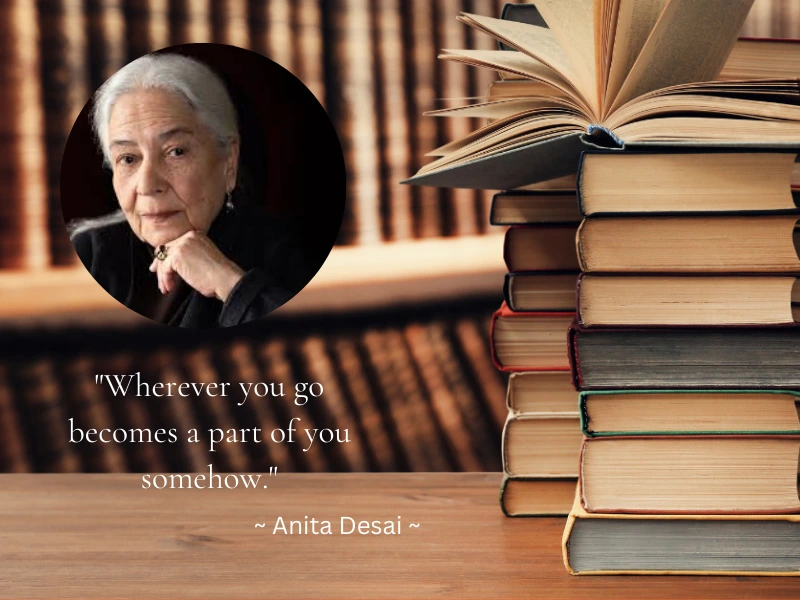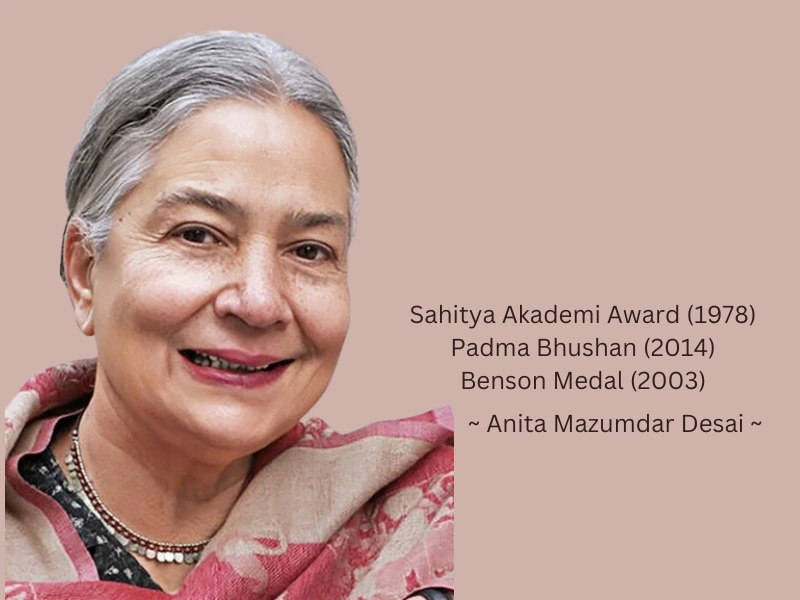Anita Desai Biography: The Literary Icon of Indian Writing
Anita Desai is an Indian writer celebrated for the profound mark she has left in modern English literature. She is acclaimed for her lyrical prose, deep insight into human emotions, and vivid narration. The writer has gained acclaim not only in India but also abroad. The blog delves into her life, career, and contributions to literature.
Early Life and Background
Childhood and Education
- Full Name: Anita Mazumdar Desai
- Date of Birth: June 24, 1937
- Place of Birth: Mussoorie, British India
Anita Desai, born to a Bengali father and a German mother, was brought up in a home that merged Indian and Western cultures; her father, D.N. Mazumdar, was a businessman, but her mother, Toni Nime developed a love for European literature within her.
She was brought up in Delhi and educated at Queen Mary’s Higher Secondary School, later studying English literature at Miranda House, University of Delhi, from where she graduated with a BA in 1957.
Influence of Multicultural Roots
Desai’s unique upbringing, surrounded by Indian traditions and European influences, deeply shaped her worldview and writing style. This cultural duality is often reflected in her works, which explore themes of identity, displacement, and the clash of cultures.
Literary Career and Famous Works
Early Writing and Debut Novel
Anita Desai began to write when very young and has published short stories in various literary magazines. It was her novel, “Cry, The Peacock,” published in 1963, that introduced her name to the Indian literary scene. The novel revolved around a woman’s inner confusion within a patriarchal society and announced Desai as a path-breaker of Indian psychological realism.
Novels
1. Cry, The Peacock (1963)
- Synopsis: Desai’s debut novel explores the psychological turmoil of a woman trapped in a patriarchal marriage, delving into themes of loneliness, obsession, and mental health.
- Significance: Established Desai as a pioneer of psychological realism in Indian English literature.
2. Voices in the City (1965)
- Synopsis: A story set in Kolkata, focusing on the lives of three siblings and their struggles with identity, independence, and societal expectations.
- Themes: Urban alienation, familial bonds, and self-discovery.
3. Fire on the Mountain (1977)
- Awards: Won the Sahitya Akademi Award in 1978.
- Synopsis: Set in the solitude of the hills, this novel portrays the isolation of Nanda Kaul, a retired widow, and the unexpected arrival of her great-granddaughter.
- Themes: Loneliness, aging, and intergenerational relationships.
4. Clear Light of Day (1980)
- Synopsis: A reflective novel about a family in Delhi, exploring the complexities of sibling relationships and the passage of time.
- Significance: Shortlisted for the Man Booker Prize and considered one of her masterpieces.
- Themes: Memory, loss, and reconciliation.
5. The Village by the Sea (1982)
- Awards: Won the Guardian Children’s Fiction Prize.
- Synopsis: A children’s novel about a poor rural family in India, focusing on the resilience of two siblings as they navigate challenges to support their family.
- Themes: Poverty, responsibility, and hope.
6. In Custody (1984)
- Synopsis: The story of a Hindi professor who becomes enamored with a fading Urdu poet and his crumbling world.
- Awards: Shortlisted for the Man Booker Prize.
- Adaptation: Adapted into a critically acclaimed film by Ismail Merchant.
- Themes: Decline of cultural heritage, language, and dreams.
7. Baumgartner’s Bombay (1988)
- Synopsis: The life of Hugo Baumgartner, a German-Jewish refugee who settles in Bombay during World War II.
- Themes: Exile, displacement, and identity.
8. Fasting, Feasting (1999)
- Synopsis: A dual narrative exploring the lives of two siblings—Uma in India and Arun in America—juxtaposing Indian traditions with Western culture.
- Significance: Shortlisted for the Man Booker Prize.
- Themes: Gender roles, cultural contrasts, and familial expectations.
9. Diamond Dust and Other Stories (2000)
- Synopsis: A collection of short stories that captures diverse characters and their struggles with love, loss, and life.
- Themes: Emotional complexity and human relationships.
10. The Artist of Disappearance (2011)
- Synopsis: A novella trilogy exploring themes of solitude, art, and modernity in a changing India.
- Themes: Creativity, environmental degradation, and personal freedom.

Short Story Collections
- Games at Twilight (1978)
- A collection of short stories exploring the emotional lives of children and adults.
- Diamond Dust and Other Stories (2000)
- Stories capturing the complexities of love, loss, and human relationships.
- The Artist of Disappearance (2011)
- A trilogy of novellas examining solitude, art, and the impact of modernization.
Children’s Books
- The Village by the Sea (1982)
- A children’s novel about two siblings navigating hardships to support their family.
Themes in Her Writing
- Inner Conflict: The psychological struggles of her characters, particularly women, form the crux of her novels.
- Cultural Duality: The tension between tradition and modernity forms a recurring theme, reflecting her bicultural upbringing in her stories.
- Family Dynamics: The complexities of familial relationships form the backbone of many of her narratives.
- Isolation and Loneliness: This is a recurring theme that delves into human emotions and existential struggles.
Awards and Recognition
Anita Desai’s literary achievements have earned her several prestigious accolades:
- Sahitya Akademi Award (1978): For Fire on the Mountain.
- Guardian Children’s Fiction Prize (1983): For The Village by the Sea.
- Padma Bhushan (2014): India’s third-highest civilian award for her contributions to literature.
- Man Booker Prize Shortlist (3 Times): For Clear Light of Day, In Custody, and Fasting, Feasting.
- Benson Medal (2003): Awarded by the Royal Society of Literature.
Also read R. N. Tagore Biography
Anita Desai’s Legacy
Mentor to the Next Generation
Besides her literary contributions, Desai has mentored aspiring writers. She taught creative writing at the Massachusetts Institute of Technology (MIT) and inspired students worldwide with her insights into literature and storytelling.
Influence on Indian English Literature
It has been credited to Desai, who redefined Indian English literature by focusing more on psychological realism and delving deep into the worlds of emotions and intellects for her characters. Her works have paved the way for subsequent Indian writers like Arundhati Roy and Jhumpa Lahiri.
Personal Life
Anita Desai married Ashvin Desai, a businessman, and the couple has four children, including renowned author Kiran Desai, who won the Man Booker Prize for her novel The Inheritance of Loss.
Interesting Facts About Anita Desai
- Multilingual Abilities: Anita Desai grew up speaking German at home, Hindi with friends, and English at school.
- Writing Style: She is known for her lyrical prose, rich imagery, and ability to capture nuanced emotions.
- Global Citizen: Though born in India, she has spent significant time in the UK and the US, enriching her global perspective.
Inspirational Quotes by Anita Desai
Anita Desai’s works and interviews are filled with profound insights into life, writing, and human emotions. Here are some of her most notable quotes:
On Writing
- “The novel is born not of the intellect but of the soul.”
- “I aim to tell the truth about any subject, not a romance or fantasy, not avoid the truth.”
- “A writer’s job is to look where others don’t want to look.”
On Life and Humanity
- “Literature is an effort to try and understand life. It’s the most sensitive instrument invented to register what happens to us.”
- “Wherever you go becomes a part of you somehow.”
- “The past is always with us, for it feeds the present.”
On Emotions
- “Loneliness is the suffering of our age.”
- “There is no escape from the mind; no one can flee from it.”
On Women and Society
- “A woman must find her own voice and not let the world define her.”
- “To be an Indian woman is to be trapped in a world of contradictions.”
On Creativity
- “Creativity means to push open the heavy, groaning doorway to life.”
- “A work of art is the result of an unending process of questioning.”
Conclusion
The amount of contribution that Anita Desai has given to literature is truly immense. With her beautiful handling of the cultural gap between Indian culture and world literature, she bridges it and stays with readers of all times around the globe, making her a true literary luminary. She began her literary journey with Cry, The Peacock and is still continuing the legacy as a mentor and a writer.
FAQs
What is the most famous work of Anita Desai?
Anita Desai’s most famous works include “Clear Light of Day”, “In Custody”, and “Fasting, Feasting”. These novels were critically acclaimed and shortlisted for the Man Booker Prize.
What is the writing style of Anita Desai?
Anita Desai’s writing style is characterized by psychological realism, lyrical prose, and rich imagery. She delves deeply into the emotional and intellectual lives of her characters, exploring themes like loneliness, identity, and familial relationships.
Is Anita Desai a feminist?
Yes, Anita Desai is considered a feminist writer as her works often highlight the struggles, inner conflicts, and societal pressures faced by women. Her female characters frequently seek independence and self-realization in a patriarchal world.
Is Anita Desai a diasporic writer?
While Anita Desai writes about themes of displacement and cultural identity, she is not typically categorized as a diasporic writer. However, her global upbringing and dual cultural background (Indian and German) influence her narratives. Her daughter, Kiran Desai, is more closely associated with diasporic writing.




At this time I am ready to do my breakfast, after having my breakfast coming
again to read further news.
My brother suggested I might like this web site. He was entirely
right. This post actually made my day. You can not
imagine just how much time I had spent for this info!
Thanks!
I love your blog.. very nice colors & theme. Did you make this website yourself or did you hire someone to do it for you? Plz reply as I’m looking to construct my own blog and would like to know where u got this from. thanks
I like this website because so much useful material on here : D.
I conceive other website owners should take this internet site as an model, very clean and wonderful user pleasant style.
My brother suggested I may like this web site.
He was once entirely right. This submit acually made my day.
You cann’t imagine simply how so much time I had
sspent for this info! Thanks! https://yv6bg.mssg.me/
Some genuinely nice stuff on this internet site, I enjoy it.
Thanks for finally writing about > Anita Desai Biography | Books, Awards,
Famous Works < Liked it! Eharmony special coupon code 2025 https://tinyurl.com/ymjk7uac